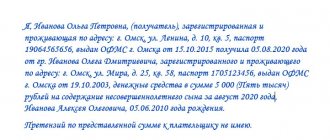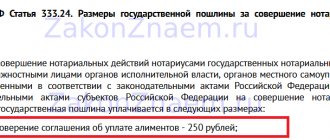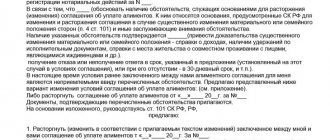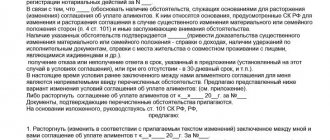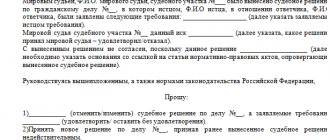Legal force of the alimony payment agreement
An alimony agreement is a document that regulates the amount of alimony and the procedure for its transfer. The agreement is concluded voluntarily, without going to court. For a document to have legal force, it must be certified by a notary.
Without a signature and seal, the contract is considered invalid. It may not be enforced and cannot be challenged in court, since in fact it has no legal force.
The parties to the agreement are the payer and the recipient. It can be:
- Children and parents;
- Mother and father of a minor child;
- Spouses and former spouses;
- Other relatives.
In 2021, under the agreement you can:
- Pay alimony as a share of income or as a flat sum;
- Transfer money monthly, quarterly or once a year;
- Transfer property or a large sum to pay for alimony.
The parties themselves establish the terms of the agreement.
How to apply for alimony?
Alimony payments can be divided into two types: voluntary and forced. The first type is an agreement signed by the former spouses and certified by a notary. All the nuances must be indicated here: the amount of payments or percentage of income, as indexed over time, the date of payments and sanctions for violating deadlines.
The Chairman of the Moscow Arbat Bar Association, Natalya Nikolskaya, advises stating in the alimony agreement what the amount of alimony should be spent on, as well as the payer’s right to control expenses. “This rule is not in the law, but this question often arises in life,” she says.
Other conditions may be provided. For example, additional expenses that the alimony provider will bear. “So, you can indicate that he will pay 50% of the cost of vacations, classes in sports sections, training in educational organizations, etc.,” says Marat Amanliev, lawyer at the Trunov, Aivar and Partners bar association.
As in the case of a prenuptial agreement and division of property, it is easier to agree on such things in peacetime, and not when the love has already passed.
For those who now cannot agree, there is only one thing left to do - go to court and write an application for the issuance of a court order or a statement of claim.
“The difference is that by filing an application for a court order, you can collect alimony only in proportion to earnings (1/4, 1/3, 1/2), if alimony is recovered in a fixed amount, then only in the manner of claim proceedings “Explains the lawyer of Burtseva, Agasieva and Partners, Vera Efremova.
Pros and cons of the agreement
Having decided to draw up an alimony agreement, it is important to familiarize yourself with the advantages and disadvantages of this document.
There is no need to participate in court proceedings to establish alimony obligations.
If the payment is made in good faith and an agreement is made with the recipient, the agreement is not provided at the payer’s place of work, so colleagues will not be aware of his family circumstances and financial obligations
If the payer does not want to advertise his income, he can agree with the recipient to establish a fixed amount
If you want to make changes to the contract, it is enough to conclude an additional agreement to it
High cost of notary services. Collecting alimony through the court is cheaper.
If you fail to pay alimony under the agreement, you will be able to collect the debt only for 3 years
Complex and controversial judicial practice on amendment and termination
To make adjustments if the other party disagrees, an application to court is required.
How to correctly draw up a receipt for alimony
How to refuse child support?
For whose benefit is it compiled?
The RF IC lists categories of persons who have the right to apply for the allocation of funds for maintenance. Payments can be assigned only to persons classified by law as disabled and in need of assistance:
- child until adulthood, i.e. before the age of 18;
- an adult child, if he is officially recognized as disabled and in need of financial assistance;
- a woman on maternity leave, as well as raising a child under three years of age;
- parents who have lost their ability to work and need financial assistance for their children;
- other family members and relatives indicated in the RF IC as recipients of alimony payments.
Important!
The agreement, which will be binding, can only be concluded by the listed categories of citizens. Persons to whom alimony cannot be assigned by law also have the right to receive money under a maintenance agreement, but this document cannot be presented for collection.
Per child
The most common case is the signing of a child support agreement in favor of a minor child. It can be drawn up at any time until the child turns 18 years old - during the period of family relationships, simultaneously with the parents’ divorce, or long after their separation.
On behalf of a minor citizen, the agreement is drawn up by the parent with whom the child actually lives. However, even if the mother and father continue to live together, a child support agreement can also be concluded according to general rules. When preparing a voluntary document for alimony, certain features should be taken into account:
- parents can agree on any amount of money that will be received monthly to support the child, but their amount cannot be lower than that specified in the RF IC;
- the child will receive the agreed payment until he is 18 years old, after which payments stop or can be made voluntarily;
- If a delay occurs, the legal representative of the minor may not go to court, but immediately submit an agreement to the bailiffs for forced retention.
The law does not prohibit citizens from drawing up the text of the agreement themselves, or entrusting its preparation to a professional lawyer. The second option is preferable, since with the help of a specialist you can take into account all the nuances of the legislation at the stage of signing the papers.
After determining the terms of monthly payments, the alimony agreement must be certified by a notary office. This service is paid; the amount of the notary fee may vary slightly in different regions.
Parents
Parents are also entitled to receive monthly payments if they are disabled and need financial support. Disability may occur due to age or due to a disability determination. The criterion of need depends on many factors - income, family status, constant need to purchase expensive medications, etc.
The amount of monthly payments is set by the parties independently; there are no legal restrictions. It must be taken into account that too small a payment amount will enable parents to go to court to force the collection of alimony in the required amount.
To other entitled persons
If other family members or relatives are disabled and need outside financial support, they may also qualify for alimony. To avoid litigation, you can resolve this issue voluntarily and enter into a mutual agreement.
The registration and certification procedure follows the general rules - written form, notarization, choice of any convenient form of payment transfer. It should be borne in mind that if one or both parties change significant living conditions, you can go to court for a forced change or termination of the alimony agreement. For example, if the payer himself becomes completely or partially incapacitated, the agreement may be terminated or significantly modified.
Amount of alimony by agreement
According to Art. 103 of the RF IC, the parties can independently determine the amount of payments. But there are also limitations. The amount of alimony should not be less than the amount that could be recovered through the court.
In accordance with Art. 81 of the RF IC in 2021, when determining the amount of payments for children, their number and the payer’s salary are taken into account:
- for one child – 25%;
- for two children – 33%;
- for three children or more – 50%.
That is, when concluding an agreement to pay child support for one child, the monthly payment cannot be less than 25% of the parent’s earnings.
Payment form
The parties have the right to establish any convenient payment options:
- as a share of income;
- in a fixed amount, a multiple of the subsistence level;
- in the form of one large payment;
- offset of property against alimony.
If an agreement is concluded by the child’s parents, then the notary checks whether the children’s property interests are respected (so that the amount of alimony under the agreement is not less than the amount collected by the court).
When concluding an agreement between adult relatives, the notary does not limit the parties when they determine the form of payments. They decide for themselves how much alimony will be paid and how it will be paid.
Payment terms and transfer procedure
Payment deadlines are regulated by the parties. They can set payment terms at their discretion:
- weekly;
- monthly;
- quarterly;
- annual;
- one-time payments for the entire period.
The procedure for transferring funds is established by agreement. It states:
- On what dates will the money arrive?
- How are transfers made: through a bank, payment systems, etc.
The recipient's details are included in the agreement. It is allowed to hand over cash to the recipient, but the payer is recommended to take a receipt each time. Otherwise, the claimant will be able to claim payment through the court again, since the payer does not have evidence of payment.
Let's look at a practical example of drawing up an alimony agreement. The couple got married in June 2013, and their son was born in August 2015. The divorce took place in January 2021. The divorce was filed through the court, the child remained to live with his mother. Before filing the claim, the parties drew up an alimony agreement, according to which the father undertakes to pay 15,000 rubles monthly. for the maintenance of his son. The document also stipulates the conditions for indexation - in accordance with the increase in the monthly minimum. The entire divorce procedure took 3 weeks. Since the parties came to mutual agreement on all problematic issues, they were separated in one meeting. In the absence of agreements, the divorce process could drag on for several months.
Concept
A child support agreement is an agreement in which one of the parties voluntarily assumes the obligation to pay child support.
In addition to minor children, alimony can be imposed on disabled parents, as well as a spouse. If an agreement is drawn up in relation to persons who are incapacitated or have limited legal capacity, then their legal representatives must be present.
A notarized agreement is permitted by the family legislation of the Russian Federation. The relevant norms are contained in Chapter 16 of the Family Code. Here we discuss various questions about how to pay alimony without going to court. The law also provides for a certain form of agreement. If it is not followed, the transaction may be declared invalid. The same applies to termination of the agreement. Therefore, you need to carefully study the law to avoid unpleasant consequences. An agreement is one type of transaction. Therefore, all rights and obligations arising from it apply to him.
Registration of a notarial agreement on the payment of alimony
An agreement can only be concluded if the payer and the recipient agree to the general conditions. They must agree:
- about the amount of alimony;
- the timing of their payment;
- date of visit to the notary's office.
The procedure for concluding an agreement is as follows:
- The parties agree on the essential terms and fill out the form.
- The payer and recipient visit the notary's office and pay for the notary's services.
- In the presence of a notary, the parties sign the agreement.
- The notary explains the consequences of concluding the agreement.
- The parties receive a copy of the agreement, the third document remains with the notary.
The notary's duties do not include assistance in drafting. But such a service can be ordered for an additional fee.
Note! When paying child support for a child over 14 years old, the agreement is concluded between him and the payer, but with the consent of the second parent (Article 99 of the RF IC).
Required documents
To conclude a deal you will need:
- 3 copies of the agreement (if the parties do not want to pay for the notary’s service for filling it out);
- passports of the payer and recipient;
- child's birth certificate;
- passport of a child over 14 years old;
- property documents (when transferring property to pay for alimony obligations);
- document on the payer’s income (if the agreement is concluded for the maintenance of a minor child).
Cost of notary services
According to paragraphs. 9 clause 1 art. 333.24 of the Tax Code of the Russian Federation, the cost of notarization is 250 rubles. This price includes only signing and sealing; the development of the agreement is paid separately.
If the parties require assistance in drawing up a document, prices vary from 5,000 to 10,000 rubles. depending on the region of residence and the specialist’s price list.
For example, in 2021 in Moscow you need to pay 8,000 rubles, and when concluding an agreement remotely - 9,148 rubles.
Agreement period
The recipient and the payer independently determine the validity period of the agreement. If an agreement is concluded for the maintenance of a minor child, then it loses relevance when the child reaches adulthood. But you can enter into an agreement for a shorter period of time: 1 year, 5 years, etc.
When an agreement for the maintenance of former spouses is notarized, it is valid until the established period or until the disappearance of the grounds on which alimony obligations arise: incapacity for work, being on maternity leave, etc.
Application to the court for the recovery of alimony
To apply for alimony, you must submit an application in writing. The application must indicate the following information:
- Name of the court.
- Details of the plaintiff (full name, address).
- Details of the defendant (full name, address).
- Plaintiff's claims. All requirements must be justified and documented.
- List of attached documents.
- Signature and date.
For documents you will need a copy of your passport, a copy of the child’s birth certificate, a copy of the marriage or divorce certificate, and a 2-NDFL certificate from work. It will also be useful to have receipts confirming expenses for the child. When filing an application, copies will be sufficient, but you will need to bring the originals to the court hearing.
The state duty in cases of collection of alimony is not charged (clause 5 of the Resolution of the Plenum of the Supreme Court of the Russian Federation dated December 26, 2017 No. 56).
Samples of alimony payment agreements
The general information in the agreement is approximately the same. The only differences are in the methods of calculating alimony and the frequency of payments. Therefore, you can draw up an agreement yourself, without the participation of a lawyer.
The contract must contain the following information:
- date and place of imprisonment;
- Full name, registration addresses, dates of birth of the parties;
- Full name, place of residence, date of birth, information from the child’s certificate;
- size, procedure and timing of payments;
- period of validity of the document;
- duties of the parties;
- grounds for termination of the agreement;
- who bears the costs of notarization;
- signatures of the parties.
To ensure proper document formatting, it is recommended that you familiarize yourself with the current samples. Their content depends on the method of payment of alimony and the category of the recipient.
About payment of alimony as a percentage of salary
The minimum amount of payments in shares of earnings is regulated by Art. 81 IC RF. When concluding an agreement for a child, the parties must establish a payment of no less than 1/4 share for 1 child, 1/3 share for 2 children, ½ share for 3 or more children.
This method is usually used if the payer has official income. In other cases, the calculation will be problematic. When entering into an agreement, alimony as a percentage of income is rarely used.
Sample agreement
On payment of alimony in a fixed amount
The most popular way to pay alimony under an agreement is a fixed sum of money. Features of a fixed payment agreement:
- if an agreement is concluded for child support, the amount cannot be less than what the court would establish;
- the payment must be proportional to the subsistence minimum (1 monthly wage, 2 monthly wage, ½ monthly wage).
The agreement is concluded according to the principles described above, but instead of the share payment method, payments in a fixed amount are indicated. To fill out, you can use the sample presented above, changing the payment method.
Sample agreement
On payment of alimony in a lump sum
The law allows for the payment of alimony in a large lump sum by agreement of the parties. The payer transfers a large amount to the recipient's account once and no longer pays alimony.
If the payment is established for the maintenance of an adult relative, then the amount is determined by the parties.
When concluding an agreement for child support, you need to calculate that the amount is not less than what the parent would pay until the child reaches adulthood.
Sample agreement
On payment of alimony for the maintenance of the wife
To collect alimony through the court, in accordance with Art. 89 of the RF IC, the wife must be disabled and in need. That is:
- be pregnant or on maternity leave;
- care for a disabled child;
- be pre-retirement or disabled.
After a divorce, the ex-wife also has the right to collect alimony on the basis of Art. 90 RF IC, if:
- pregnant or on maternity leave for up to 3 years;
- needs financial support and cares for a disabled child;
- disability was established during marriage or within 1 year after its dissolution;
- needs financial assistance upon reaching pre-retirement age no later than 5 years from the date of divorce, if the marriage lasted more than 5 years.
But when concluding an agreement, the wife or ex-wife may not meet the listed conditions. If the spouse/former spouse agrees to provide for her, then the notary will certify the agreement without any problems.
Sample agreement
About paying child support for parents
According to Art. 87 of the RF IC, able-bodied adult children are obliged to support their disabled parents if:
- the parent has a disability;
- the parent has reached retirement age.
But at the same time, for the court it is necessary that the parent’s income is not enough to buy food, clothing, medicine and pay for utilities. If a mother or father needs financial help, but the child is not ready to provide it just like that, it is better to enter into an agreement.
Advantages of concluding an agreement to pay child support to parents:
- the parent will not be able to collect child support through the court;
- the parent will not be able to collect child support for the past period;
- the amount can be revised only with the consent of the payer;
- the agreement can specify the period during which alimony will be paid;
- You can set any amount that the parties agree on (there is no minimum amount).
Therefore, if a child doubts the parent’s integrity and wants to formally record the payment of alimony, then it is better to formalize an agreement. Payments under the agreement must be made through the bank. The purpose of payment must indicate: Alimony for __.____ year.
Sample agreement
What is regulated
The main legislative document on the basis of which the alimony agreement is drawn up is the Family Code of the Russian Federation.
It establishes the regime for maintaining the child, and also determines a number of other points. All of these will need to be dealt with first. This will prevent many difficulties and problematic situations.
Find out how to collect alimony for an adopted child in the article: alimony for an adopted child. If you are interested in how child support is paid if the father is an individual entrepreneur, read here.
If you want to know what rights a father has to a child when paying child support, look here.
Today, the process of obtaining alimony has its own subtleties and difficulties. But overall it doesn’t cause any big problems. It is only important to understand in advance how exactly the registration is carried out.
Invalidation of an agreement to pay alimony
The invalidity of the agreement is determined by Art. 102 RF IC. An agreement can be declared invalid through a court if the terms significantly violate the interests of the child or one of the parties.
An agreement can be declared invalid in the following cases:
- signing an agreement by a teenager without the written consent of the parents;
- one of the parties at the time of concluding the agreement did not realize the consequences due to strong medications, alcohol, drugs;
- drawing up a contract fraudulently or under duress;
- an illegal method of fulfilling alimony obligations has been established (transferring psychotropic or narcotic drugs as alimony, etc.);
- there is no notarization;
- concluded for appearances in order to avoid forced collection of property;
- one of the parties is completely incompetent (a child under 14 years old, an incompetent adult, etc.).
The procedure for recognizing the invalidity of an agreement
The recipient or the payer can go to court to invalidate the agreement.
The process looks like this step by step:
- Payment of state duty in the amount of 300 rubles. The receipt must be kept - it is attached to the rest of the documents.
- Drawing up a claim and submitting documentation to the district court at the defendant’s place of residence.
- Participation in legal proceedings. The period for consideration by the district court is 2 months.
- Obtaining a court decision and writ of execution.
If the agreement is contested by the recipient, he may, along with a request to invalidate the agreement, indicate the collection of alimony through the court. If the agreement was presented to the bailiffs or to the accounting department at the payer’s place of work to withhold alimony, the writ of execution is subsequently submitted there.
Forms of alimony payments
The legislation establishes the following forms of payments:
- as a percentage of the payer’s earnings;
- in a fixed amount, paid once or on a regular basis;
- through the provision of property;
- by other means based on voluntary agreement.
The percentage method is the most common form of alimony payments. For one child, 25% of the alimony payer’s earnings are due, for two children – 33%, for three or more children – 50% of the payer’s income. This option is used if the parent has a stable, regular salary in Russian rubles.
Child support in a fixed amount is paid if the parent’s earnings:
- irregular;
- in kind;
- in foreign currency (both fully and partially);
- absent;
- violates the property rights and interests of the child.
Alimony in a fixed amount is established as a multiple of the minimum subsistence level in force in the area of residence of the child.
What is alimony in a fixed amount?
The court sets alimony only as a percentage or in a fixed amount.
The parties can voluntarily choose other methods - through the provision of property (apartment, car, medicine, clothing, shoes, food). The list of such objects is unlimited and depends only on the needs of the child.
Lawyer's answers to private questions
Is it possible to conclude an agreement if there is a writ of execution?
Yes. To do this, the recipient must submit an application to the bailiffs to revoke the writ of execution, after which an agreement is concluded.
Is it possible to formalize a marriage agreement?
Yes. Drawing up a contract is allowed during marriage, during its dissolution or after a divorce.
Is alimony indexed when paid by agreement?
Indexation of alimony is provided for in the agreement itself in a separate paragraph. In the absence of such, recalculation is made in proportion to the increase in the cost of living in the region.
Do I need to submit the agreement to the payer organization?
Not necessarily, but if the payer does not fulfill the terms of the agreement, then the claimant has the right to submit it to the enterprise for forced deduction of alimony from the payer’s salary.
How can I change the terms of the agreement?
If the recipient and the payer agree to make changes, then you need to contact a notary. And if someone is against it, then only through the court.
Execution of the agreement
Once the agreement is notarized, it acquires the force of a writ of execution. It is quite possible to contact the bailiffs if alimony is not paid.
Some nuances
If the agreement contains conditions that violate the rights of the alimony recipient, it is invalid. To protect himself, the interested party should contact the judicial authorities.
If the alimony payer quits, accounting employees must inform the alimony recipient or bailiffs about this within three days.
If any changes are made to the agreement, they should be certified in the same way as the agreement. In this case, a new agreement is drawn up, and the old one is canceled.
Alimony payment terms
The RF IC provides that the parties themselves determine the frequency of payments. Formally, this means that the principle of monthly payments does not have to be observed, but the concept of frequency implies a certain regularity. If such a rule is not specified in the agreement, payments may be one-time and unsystematic, which significantly violates the interests of the recipient.
It is better to establish a monthly payment amount, and specify individual cases of deviation from this rule in detail in the contract. This will allow you to avoid mutual disputes and claims that could result in a complex lawsuit.
From what income?
In accordance with Art. 82 of the RF IC, alimony must be withheld from all types of income of the debtor, with the exception of a number of personal payments (for example, a survivor’s pension). This list is also established by Decree of the Government of the Russian Federation dated July 18, 1996 No. 841.
In the text of the agreement, the parties can voluntarily stipulate from what amounts alimony will be transferred (for example, only from earnings from one place of work), and what income will be exempt from withholding. These rules can only be changed by mutual agreement or by going to court.
When can you enter into an alimony agreement?
An agreement is a contract concluded voluntarily between parents. Therefore, for its registration, the consent of both parents is required. And such a document must be drawn up in accordance with the norms and notarized. You can receive alimony not only for child support. The right to receive alimony (including by agreement) has:
- all minor children;
- adult children with disabilities;
- wives on maternity leave, pregnant women;
- women not working due to parental leave;
- spouses experiencing financial difficulties;
- parents who are in difficult financial situations.
It is important to understand that a peaceful way to resolve the issue of alimony is relevant only until extreme measures are taken. That is, at any time before trial or during legal proceedings. Immediately after the court makes a decision, it will not be possible to conclude it.
Is it possible to pay alimony without it?
Every child has the right to support from their parents. An agreement is the easiest and simplest way to fulfill this parental responsibility.
This agreement between parents does not have to be formalized legally. Some people maintain such trusting and friendly relationships that there is no need to record a verbal agreement on paper. You can simply agree verbally and fulfill your promises in good faith. But in such cases there are also disadvantages. The receiving party must keep checks, receipts and other payment documents confirming the transfer of money. If alimony is transferred in the form of cash, then you can sign a receipt for receipt of funds. Keeping these documents will help avoid misunderstandings if the case suddenly goes to court.
Important: if the alimony provider ceases to conscientiously fulfill the terms of the oral agreement, and the other party files a claim in court, then the payment of alimony will be ordered from the moment the claim is filed.
For the past time, alimony is not assigned. An exceptional case when they can force you to pay for the past 3 years. But to do this, you need to collect enough evidence that you diligently sought payments out of court, and the defaulter refused to pay. In practice, few people manage to prove this.
Does the agreement cancel the writ of execution?
The agreement itself, if drawn up in accordance with the law, has the force of a writ of execution. Article 106 of the Family Code states that a lawsuit can only be filed when there is no valid agreement. That is, these two documents are incompatible, and an attempt to combine them is an illegal act. So, if there is an agreement, but you need to file a claim, you can do the following:
- terminate the agreement and then file a lawsuit;
- file a claim with two demands at the same time: for termination and for the collection of alimony.
The situation is much more complicated and confusing when everything happens the other way around. The court decision comes into force, and after that, for some reason, the parties agree and enter into an agreement. For example, after the divorce, Ivanova filed for alimony. The child is the only child in the family, and Ivanova’s ex-husband is a major entrepreneur with a high level of income. Thanks to accounting (this is important), the defendant provided income certificates that differed significantly from reality. The court appointed alimony in the amount of 6 thousand rubles. Of course, this did not suit the plaintiff. But this also did not suit Ivanov, since he was not going to save on his son. It turned out to be unprofitable to transfer money just like that (from an accounting point of view), and the costs of maintaining children had to be reflected in the documents somehow. The former spouses entered into an agreement. This suited everyone.
A small nuance: Russian legislation does not regulate the issue of concluding a notarial agreement with a valid court decision. Therefore, in such cases, it is possible to state in the document itself that the previously issued writ of execution has lost force. In practice, more than half of the notaries, when drawing up such an agreement, are not even interested in whether there is a court decision.
Termination
The rules for terminating transactions apply to alimony agreements. If the parties do not have a mutual agreement to terminate the alimony agreement, this can be done through the court. The grounds for judicial termination will include significant and repeated violations of the terms of the agreement, as well as a change in the financial and family status of the parties, which makes it impossible to comply with the prescribed obligations.
Also, this document may be declared invalid if the law was violated during its conclusion. Termination of an alimony agreement in court does not deprive the recipient of the right to go to court to force the withholding of funds for maintenance.
Change
The rules for changing the alimony agreement comply with the provisions of Art. 450 of the Civil Code of the Russian Federation for transactions. In particular, the basis may be a mutual decision of the parties (for example, the desire to improve the child’s standard of living by increasing the amount of payments). If there is no such consent, a unilateral change is permitted only through judicial proceedings.
The reasons for going to court must be related to a significant change in the terms under which the parties signed the original agreement. For example, if the payer has become disabled and has suffered a significant loss in wages, he can legally obtain a change in the contract and reduce payments for the child. All circumstances must be proven by the plaintiff in court proceedings.
Responsibility for a non-notarial agreement
Since the alimony agreement is subject to the rules of civil transactions, failure to comply with the form of the document entails its legal invalidity. This means that the payer will not be able to make any claims in case of delay or unilateral refusal to allocate funds. In this case, it remains possible to collect alimony through the court.
If the agreement does not have a notarization mark, it cannot serve as an executive document. Bailiffs will not accept such a form to initiate enforcement proceedings. However, even in the absence of a notary stamp, the payer can fulfill the terms of the agreement voluntarily in order to avoid litigation.
